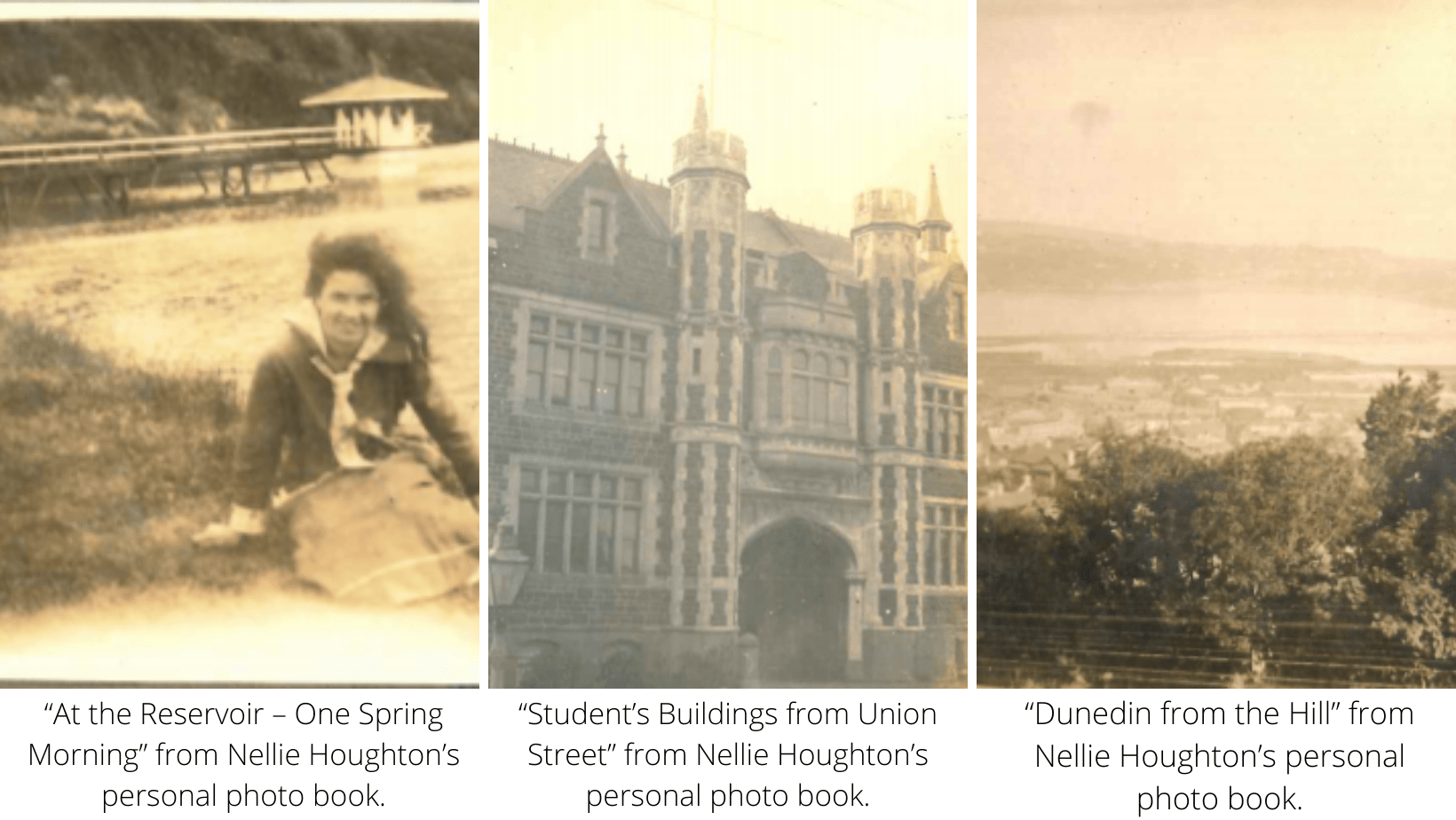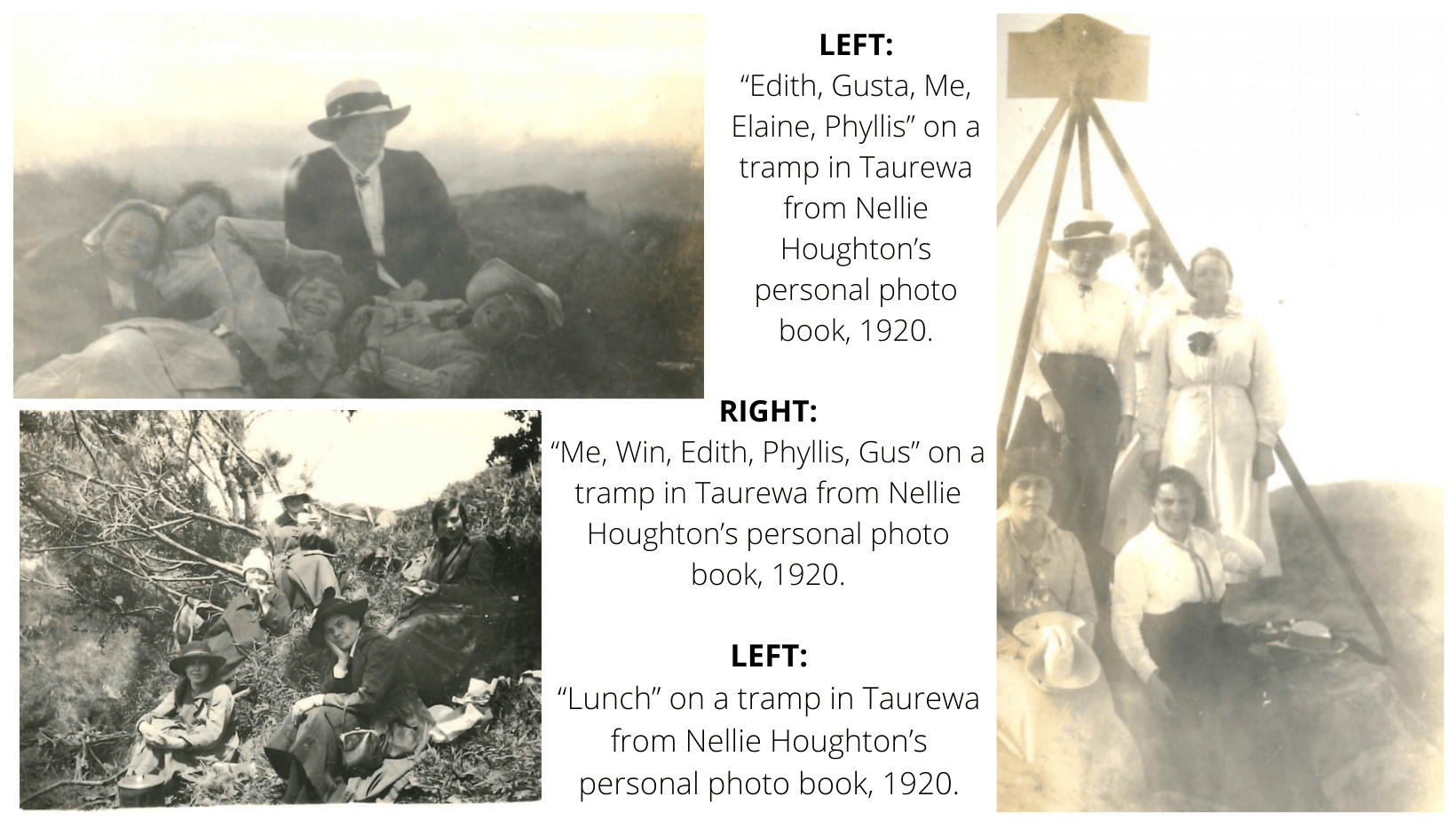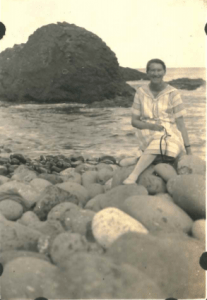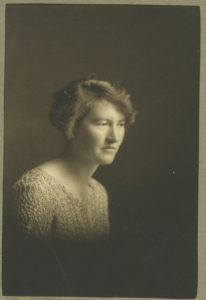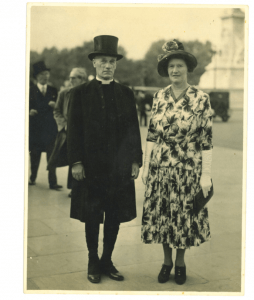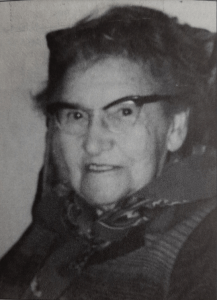This biography is based on an interview with Sam and Jenny Bufton in 2021 for the Early Medical Women of New Zealand Project.
1928 GRADUATE
Contents [hide]
Growing Up on a Farm & Achieving Well at School
Nell Isabel Houghton, who was affectionately called Nellie by her family, was born on the 3rd December 1898 to Charles (Charlie) Graham and Euphemia (Effie) Houghton. Nellie was born in The Terrace in Rintoul Street, Wellington, where both her mother (b. 1866) and maternal grandmother (b. 1843) had been born. She was the first of two children; her younger brother Victor was born in 1901. Charlie was born in Ashley, Canterbury but his family had moved to Manakau to farm. It was in Manakau that he met Effie. They were the first couple to be married in the little Manakau Church. Charlie and Effie first settled in Marton, where they had both of their children. While in Marton, Nellie attended a young ladies school.
When Nellie was 10 years old, the family moved to a farm on Parapara Road, nine miles out of Raetihi. The farm was 1,000-acres, and the Houghton’s leased it from the local Maori iwi who owned the land. “And this land was in-fact farmed by the family until the 1980s, when it was handed back to the iwi”. Nellie was enrolled in Wanganui Girls’ College where she achieved well both academically and in sports. She attended as a boarding student. Although almost her entire family were in farming (her mother was a housewife and a few of her relatives were nurses), “she was keen to study medicine”.
Otago Medical School, Travelling, & Getting Tuberculosis
Nellie moved to Dunedin, where she enrolled in a Bachelor of Medicine and a Bachelor of Surgery (MBChB). There were three women in her class, and she became very close to many of the other women she studied alongside. She recalled, “in the anatomy and dissection rooms, it was pretty annoying because they found doctors would put various bits of human anatomy in the girls’ lab pockets”. As part of her practicum, she was enlisted to help nurse back to health the men who had returned from World War One. Unfortunately, she contracted tuberculosis from this work and was sent to a sanatorium at the head of Lake Whakatipu. This was a very private part of her life of which she barely spoke. Her son, Michael, only heard about it “because on a school form which she filled in for me, she wrote in the family history column “maternal TB”.” This caused her to miss a year of her studies, putting her a year behind many of her friends.
Outside of her studies, Nellie had an active social life. She was a member of the Student Christian Movement, which became very important to her and “prepared her for her future as a vicar’s wife”. She also captained the University Netball Team and spent a lot of her holidays tramping around New Zealand. She fondly remembered swimming in the crater lake at Mount Ruapehu. She took many photos on these hikes.
Despite missing a year due to her illness, Nellie completed her studies in 1927 and attended her capping ceremony early in 1928 before moving to Wellington.
Marriage to Percy and Early Career
In 1927, Nellie had travelled to Wellington. There, she connected with a distant relative, Percy Houghton, who had moved to New Zealand from England following the death of his first wife. He had taken up the position of vicar at St Matthew’s Church in Brooklyn. In fact, Percy came from a long line of clergy; “I think he was either number five or number six”. Despite the age difference (Percy was 20 years Nellie’s senior), the two fell in love and quickly became engaged. However, Nellie had to return to Dunedin to complete her medical training. She moved into Weir House, a student hall at the University of Otago. Then, upon the completion of her studies, she returned to Wellington where she married Percy on the 16th October 1928. They were married at St Paul’s Cathedral.
Nellie established a small practice that ran out of the St Matthew’s vicarage where Percy was employed. She ran this practice for three years while starting a family. Their first child, Michael, was born in 1929 and their second, Adrienne, was born in 1931. The family then decided to move to Auckland, where Percy took up a position at the St Mark’s Vicarage in Remuera in 1932. Nellie thoroughly enjoyed this period of their life. “She enjoyed parish life” and became an active member in other areas of the medical community outside of her practice. For example, she joined and later became the vice president of the Federation of University Women, ran lectures for the St John’s Ambulance training centre, examined women students for the Auckland Teachers Training College, and taught health lessons at Diocesan School for Girls to sixth formers. The latter position highly embarrassed her children, as she would teach the “facts of life” with ink sketches of Michael and Adrienne.
In 1942, in the middle of World War Two, Nellie was approached by the Health Department. They explained that due to the high volume of doctors who had gone overseas for the war, a number of doctors were required to fill the medical officer positions in local schools. She approached the St Mark’s Vestry with this proposition and was granted permission to enter into this part-time, salaried position. Michael later commented that this was a rather traumatic time in their household, as the two children were sent to boarding schools, both of which were less than a mile from their home, “and we became a two car family”. This role included administering vaccines at the schools and practising out of the Health Department headquarters in Symonds Street. She conducted research into families who had contracted poliomyelitis and worked for the School for the Deaf in Lopdell House, Titirangi, and then Kelston.
Moving House & Travelling “Home”
In the late 1940s, after seventeen years of service in a vicarage, Percy retired at 65 years of age. Nellie’s mother had passed away early in 1949 and the couple moved to a house Nellie had designed and their gardener, who was a skilled carpenter, had built; they called it Woodholm and it was located in Woodlands Park, Titirangi. Adrienne and her family moved in with Nellie and Percy for a short while at Woodholm. Sam Bufton (Nellie’s grandson and Adrienne’s son) remembers that after they moved out of Woodholm, it became a Sunday tradition to visit every Sunday and every Christmas Day. He remembers she had a bush track with many native plantings. Nellie loved the bush and was very knowledgeable about flora and fauna. Many of her books had pressed ferns and leaves in them. She joined the Lily Society and was a member of the Rhododendron Society, of which she made Sam a member of perpetuity “because she thought I would benefit from that”.
Nellie and Percy were also both keen sportspeople and were for many years actively involved in the Maungakiekie Golf Club, located at Cornwall Park. They also enjoyed walking long distances; Michael remembered them walking from Raetihi to Pipiriki on the Whanganui River. However, Percy developed diabetes which prevented him from participating in most sports and activities.
By this point, their son Michael was attending Cambridge University in England, which they called “home”. In January 1950, Nellie and Percy set off to visit him. They spent most of 1950 travelling around England, making “a point of visiting places where work was being done for hard of hearing children”. One highlight from this trip was a royal garden party held at Buckingham Palace that they attended. Both Queen Elizabeth and the Duke were present at this party; they shook hands with one of them though “memory doesn’t recall whom they shook hands with”.
Upon their return to New Zealand, Nellie increased her working week hours at Kelston branch of the Department of Health, where she worked until age 65. In 1954, the same year that their grandchild Nigel was born, Percy passed away. She continued to work with members of the Parish, annually packing a large number of gift boxes full of medical supplies, clothing and other necessary household items. She also did much for the Melanesian Mission and visited people in need “with her hands gloved and leaving her little visiting card”.
A New Chapter: Retiring But Never Stopping Learning
Not long after her retirement at age 65, Nell had an accident. Sam Bufton, one of Nellie’s grandsons, recalled: “Mum [Adrienne] used to breed Cairn Terriers and grand had always had a Cairn Terrier for a number of years and one of them had died so she got a new one, it was a puppy, and she went to put up little barriers for the puppy, well she fell over it. She smashed her shoulder, ended up in hospital, then had multiple heart-attacks and then paralysed her right arm”. The nerve damage in her right arm caused her to learn to write with her left hand. Indeed, she never stopped pushing herself. Even in her old age, she was learning Te Reo Maori and she learnt to type when writing started to prove difficult.
After the accident, Adrienne built a small two-bedroom house on the rear of her property so that she could look after Nellie. “So we fed her from there and because it was a new little house, I [Sam] did all her gardening with her and stuff … She was just a lovely lady. We had a chat every afternoon to make sure she was okay and a cup of tea. But she was always active. She was out in the lawn car. She’d be off to the university or off to something or other”. Sam recalled that she swam most mornings.
After a few years at Adrienne’s, Nellie moved to Selwyn Village: “And the only reason we moved [her] there is because as a family all the kids had moved, left home bar me [Sam] and Mum and Dad … So the family home was sold up and Gran moved on”. This move proved fruitful for Nellie as she entered into a new phase of her “career”. Not only did Selwyn provide for her spiritual development through her membership of the Franciscan’s tertiaries, but she took this opportunity to observe the aged and dying, with a particular interest in their understanding of and attitudes towards death. She read many academic publications on the matter and then constructed a 5,000 word article entitled “Death with Dignity” that was published in the 1977 edition of the New Zealand Medical Journal. Sam commented that this as “ahead of its time really … people weren’t really talking about death with dignity back in those days”. Nell wrote:
Whether it be in a senior citizen’s flat in Auckland, in homes or villages for the elderly, in geriatric hospitals or hospices for the dying in the wider world, the ideal of death-with-dignity should be steadfastly held and practised. To the Christian, death in the elderly is not defeat but victory. I recently heard one of our younger theologians say, addressing a group of senior citizens, ‘When we trust out lives to God we also trust our deaths to Him. For death is a part of life, not something separate, or as someone has expressed it, death is the final stage of growth for a Christian. It is not failure, but success; it is not defeat, but victory.”
As a result of this article, Nellie received many letters and enquiries, one of which was from a doctor in Tonga who invited her for a visit. She accepted and flew there by herself at the age of 81.
Final Years
Nellie continued to drive, right until a month before her death. Her opinion was: “I’ll take all the old people out because they can’t get out so I’ll drive them around the place”. Nellie was a good driver and she never had a crash, even though “her interests seemed to be all around her and her comments indicated she saw a lot that was not on the road.” “She was known to wave to hitch-hikers, believing them to be waving to her!” “That was typical of her, of her way of life. Yet she never had a crash, or ran off the road.” Sam recalled hearing the story of how Nellie got her driver’s license. “It was in Raetihi, and she went to the local police station to apply for a driver’s license and the policeman said, “I’ve been watching you driving for the last number of years. About time you got your license”.”
In 1973, the New Zealand Federation of University Women celebrated its Golden Jubilee and wished to honour those on the executive both in the past and the present that had made a considerable difference. Nellie was put forward “to thank you most warmly for your sustained and loyal service to the Auckland Branch”.
In 1983, Nellie became ill and was moved to the sick wing at Selwyn Village so that she could be better looked after. She had been living independently in a small unit. The illness lasted approximately four days before Nellie passed away peacefully. The funeral service was held at Selwyn Village and her ashes were buried with her husband’s in the churchyard at St. Mark’s.
Bibliography
- Interview with Sam and Jenny Bufton
- Michael Houghton, A Brief Glimpse into the Houghton Story, 1998.
- Michael Houghton, “Nellie Isabel Houghton: 1898 – 1983”, in Women Doctors in New Zealand: An Historical Perspective, 1921-1986, IMS (N.Z.) Limited, pp.129-131.
- Letter to Nell Houghton from the New Zealand Federation of University Women, 1973.


